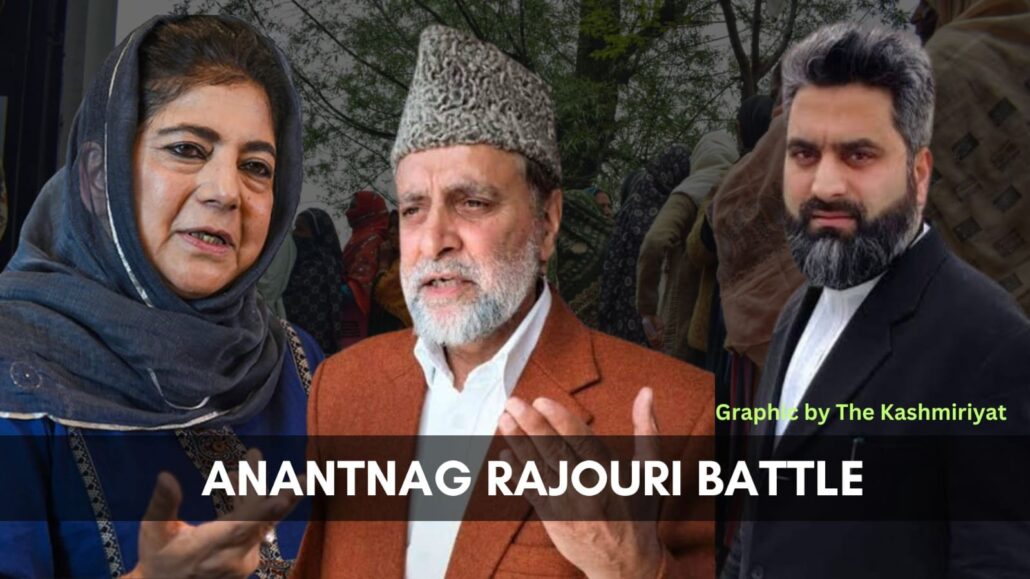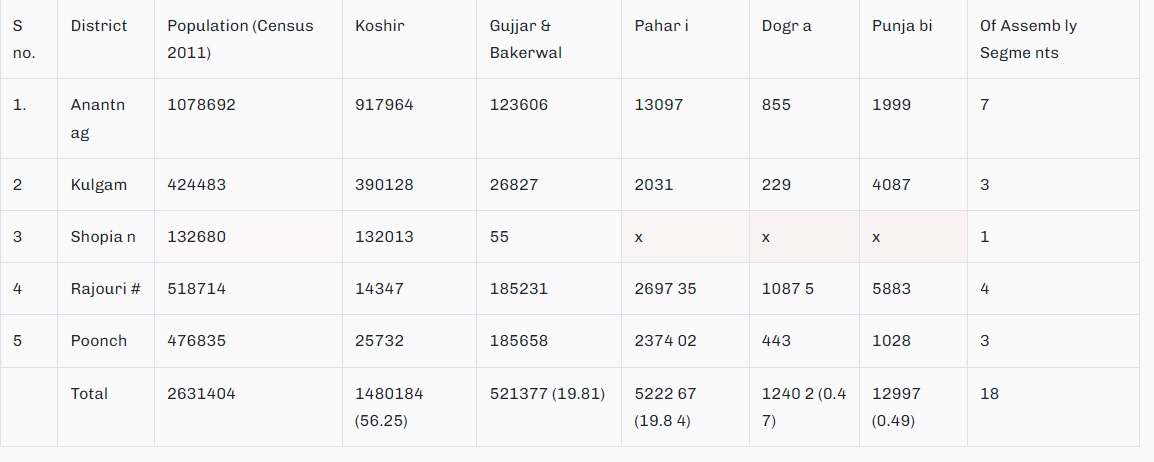
With two phases of elections concluded in the Kashmir valley, all attention is now riveted on the Anantnag-Rajouri seat, which has become the focal point of intense campaigning following a deferment requested by the BJP and others.
Former Chief Minister Mehbooba Mufti is contesting this seat, making it a crucial battle for the survival of the People’s Democratic Party (PDP), which has seen an exodus of members to the Apni Party and others.
The newly-formed DPAP initially proposed former Chief Minister Ghulam Nabi Azad as their candidate for the Lok Sabha seat but ultimately decided to field Advocate Saleem Parray.
In a significant departure from tradition, the Bharatiya Janata Party (BJP) has not fielded any candidates in this constituency for the first time in decades. Meanwhile, the Apni Party has put forward Zafar Iqbal Manhas, further intensifying the contest.
Iltija Mufti, media advisor to parliamentary candidate and former Chief Minister Mehbooba Mufti, stated, “Despite exhausting all possible strategies to secure this seat, the BJP refrained from fielding a candidate here, fully aware of their inevitable and resounding defeat in Kashmir.”
The Anantnag-Rajouri seat is poised for a gripping contest between the People’s Democratic Party (PDP) and Mian Altaf of the National Conference. Mian Altaf is majorly banking on the support in rural area of Anantnag and Rajouri while Mehbooba Mufti holds majority of her support in urban areas.
Once considered a bastion of the People’s Democratic Party (PDP), Mehbooba Mufti lost the Anantnag seat in 2019, securing merely 30,524 votes. The winning candidate, Hasnain Masoodi of the National Conference, narrowly edged out the competition with a total of 40,180 votes. The overall voter turnout for the Anantnag seat was notably low, recorded at a meager 8.76 percent.
The people of the Anantnag seat, which before delimitation and the subsequent addition of the Rajouri area included the districts of Shopian, Kulgam, Pulwama, and Anantnag, largely boycotted the polls. This boycott was fueled by a growing anger against the then-incumbent Chief Minister Mehbooba Mufti.
The dynamics in the valley have evolved significantly over the years. The substantial voter turnout in the Lok Sabha elections in Srinagar and Baramulla has set a new precedent for South Kashmir. This shift suggests that a large number of people in the Anantnag-Rajouri seat are now expected to come out and exercise their voting rights in substantial numbers.
Anantnag-Rajouri Lok Sabha seat has a total electorate of 18,30,294 persons including over 80,000 first time voters. The list comprises of 9,30,379 men and 8,99,888 women. The seat is slated to go for polls on May 25 with 25 candidates in the fray.
Rajouri’s addition
The Delimitation Commission in its report dated February 05, 2022 sought the merger of Rajouri and Poonch into Anantnag Lok Sabha seat, among several other changes. In its report, the assembly segments were heavily scattered against the existing structure of the seats.
In earlier instances, seats in Jammu Kashmir were delimited in 1963, 1973, and 1995. The last commission of 1995 was headed by Justice K.K. Gupta. The next delimitation was scheduled in 2005, but in 2002, the then state government froze the delimitation process until 2026.
However, after the abrogation of Article 370 by the Modi-led government in 2019 August, a delimitation Commission was formed by the Government. Assembly elections have not been held in the region after June 2018 when the BJP pulled out of the coalition Government with PDP.
The commission in its proposal discussed in New Delhi increased the number of Assembly seats in the Jammu region from 37 to 43 while in Kashmir the tally has been increased from 46 to 47, Pulwama, Shopian, Tral are now be a part of the Srinagar Lok Sabha seat.
Of the total 1,925,450 voters in the Anantnag-Rajouri Lok Sabha seat, approximately 1.1 million are from South Kashmir (Anantnag and Kulgam, Shopian), while the twin border districts of Rajouri and Poonch in the Jammu province account for over 800,000 voters.
The Poonch and Rajouri districts within the Anantnag-Rajouri seat have a sizable tribal population, including Gujjars, Bakerwals, and Paharis. Recently, the central government announced Scheduled Tribe (ST) reservations for the Paharis and three other communities.
As per the 2011 census, the total population of the Poonch and Rajouri districts is 9,95,549 and nearly 3,70,289 belong to the Gujjar and Bakerwal Scheduled Tribes group; 185658 in Poonch and 185231 in Rajouri.

This move has led Pahari leaders to assure the BJP of their community’s support, however, in the absence of BJP in the poll fray, their vote is expected to be dispersed among all the regional parties.
Iltija Mufti told The Kashmiriyat, “The addition of Rajouri and Poonch to Anantnag also did not work out for the Bhartiya Janta Party, now they are trying to intimidate the Pahari voters to vote for their proxy candidates or else they will snatch their recent inclusion in the Scheduled Tribes list.”
Numbers and figures
With an energetic young cadre campaigning door to door, the People’s Democratic Party is set for a close contest with the National Conference. The latter’s campaign is driven by senior leaders who have been largely absent from the public eye as they focus on canvassing in remote areas.
Mian Altaf, a popular Gujjar leader, has been strategically introduced to the people of Anantnag by the National Conference, which is seeking votes from the Kashmiri linguistic group for a Gujjar candidate. This mirrors the party’s strategy in Srinagar, where they solicited votes for a Shia candidate in Sunni-majority areas.
Political experts from the Kashmir valley believe that this calculated move highlights the party’s efforts to bridge community divides and garner broad-based support across diverse demographic groups, however, if the strategy works on the ground needs is something time will decide.
Several time MLA, Mian Altaf is quite popular among the Gujjar and Bakerwal populace, inhibiting the areas of Rajouri and Poonch and several other clusters of the south Kashmir’s Anantnag district, however, seasonal migration of Bakerwals may have any impact on the vote of Mian Altaf.
The Gujjar and Bakerwal population from Rajouri has initiated its migration to Kashmir valley ahead of the Eid ul Adha The tribal population moves in along with their sheep and cattle to the plains of the valley to sell the animals ahead for sacrifice on Eid ul Adha.
“We would not be moving back to vote. Moving back is not very easy for us,” said Ghulam Nabi Gojri, selling sacrificial animals in the Anantnag town.
The National Conference has garnered support from the Indian National Congress, and the CPI (M), led by M.Y. Tarigami, has also announced its backing for the region’s oldest party while the People’s Democratic Party has a revived cadre throughout the southern region and also enjoys suport from several activists in Rajouri, popular on social media.
In 2014, the people’s Democratic Party bagged a total of 28 seats; three of them in Poonch and Rajouri and in the south Kashmir region it bagged eleven seats.
The People’s Democratic Party previously secured seats in Dooru, Kokernag, Bijbehara, and Noorabad, establishing a strong influence throughout the region. However, the party now faces a significant challenge as many of these elected representatives have since departed.
Abdul Rahim Rather, in 2014 defeated his close rival by securing 1,280 more than Peerzada Mohammad Sayeed. Rahim Rather, Abdul Majid Padder, who won the Noorabad seat of Kulgam on the PDP ticket, have joined the Apni Party after quitting PDP.
Many other influential leaders, including Peerzada Mansoor, have also left the party, while the entrance of Peerzada Touqeer of Kokernag to the NC cadre is expected to significantly impact the National Conference’s vote bank in rural Kokernag.
The support of influential leaders such as Shangus Advocate Riyaz Ahmed Khan and Zafar Chowdhary will also sway voters in the Kokernag belt.
Chowdhary Haroon, who won the DDC seat in Sagam Kokernag and has now shifted allegiance to DPAP, holds major influence among the tribal voters.
Talib Hussain, a prominent human rights activist, will be a key figure in mobilizing support for the People’s Democratic Party in the Kokernag belt.
In Pahalgam belt, Altaf Ahmed Kaloo will be a strong candidate who can woo voters to vote for the National Conference while the former People’s Democratic Party MLA Pahalgam and strong face of the party, Mohammed Rafi Mir has joined the Apni Party.
In Kulgam’s rural belt, Sakeena Itoo of the Jammu and Kashmir National Conference enjoys widespread support. Additionally, Mohammed Amin Mir of DPAP holds significant influence across this South Kashmir region.
The People’s Democratic Party is poised to outperform the National Conference in Shopian, bolstered by several key leaders actively campaigning.
The PDP has been rigorously canvassing every corner of the constituency and, according to experts, holds majority support in the urban areas. However, whether the urban population will turn out to vote remains uncertain.
This phase will starkly reveal the rural-urban divide. Unlike in the North Kashmir seat, the youth in this region are less likely to connect with the candidates in the fray, However, the politics in Kashmir is far from black and white.




